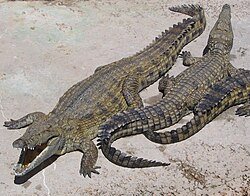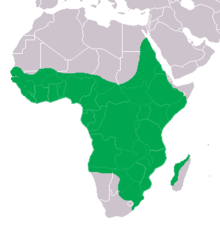Nile crocodile - Simple English Wikipedia, the free encyclopedia
| Nile crocodile | |
|---|---|
 | |
| Scientific classification | |
| Kingdom: | |
| Phylum: | |
| Class: | |
| Order: | |
| Family: | |
| Genus: | |
| Binomial name | |
| Crocodylus niloticus | |
 | |

The Nile crocodile (Crocodylus niloticus) is the largest of the four crocodile species found in Africa. They have a long tail and powerful jaws. Their back feet are webbed for swimming. They can grow up to 20 ft (6.1 m) in length and can weigh up to 1,500 lb (680 kg).[1] The males are usually bigger than the females.
Nile crocodiles are also found in Madagascar, sub-Saharan Africa and the Nile delta.[1] They were previously also found in Jordan and Israel.[2] They live in different habitats including lakes, rivers, estuaries, freshwater marshes, and mangrove swamps.[1]
The Nile crocodile is carnivorous. It eats bigger animals as it grows. Young crocodiles eats insects and small fish, while adult crocodiles may catch and eat birds, zebras, antelopes, wildebeests and buffalo.[2] The Nile crocodile will attack anything, even other crocodiles.
The crocodiles mate in the water, and then the female lays her eggs in a hole dug in the ground. They can lay 60 eggs which take about 90 days to hatch.[2] The female guards the eggs, or is nearby, until they hatch.[1] Young crocodiles are able to reproduce when they get to about 12 years old.[2]
The muscles responsible for opening the mouth are exceptionally weak in comparison to the strength of the muscles for closing.
References
[change | change source]- ↑ 1.0 1.1 1.2 1.3 "Nile Crocodile". Nile Crocodile - National Geographic. National Geographic. January 14, 2016. Retrieved January 14, 2016.
- ↑ 2.0 2.1 2.2 2.3 "Nile crocodile - Crocodylus niloticus". arkive.org. 2012. Archived from the original on 23 January 2009. Retrieved 19 November 2012.


 French
French Deutsch
Deutsch